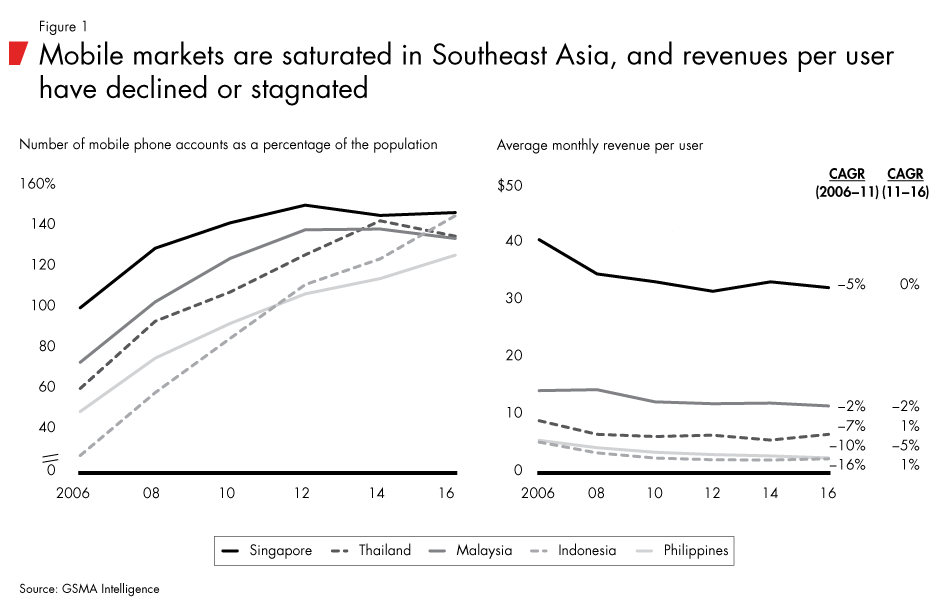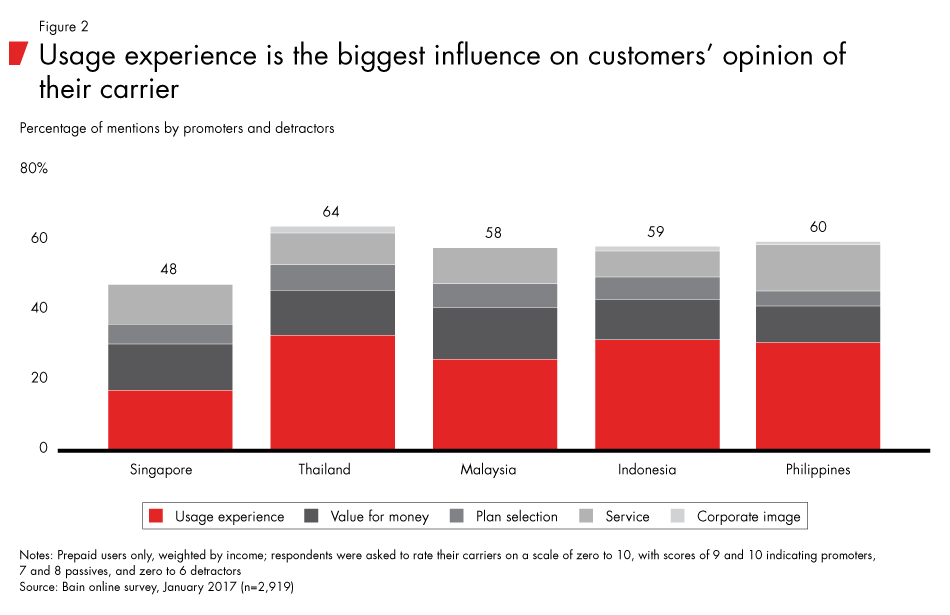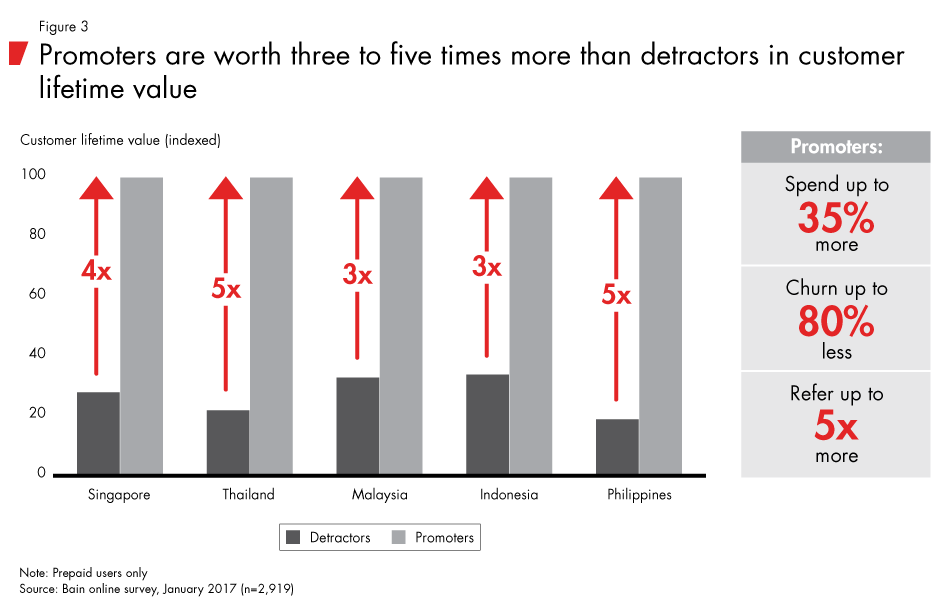Brief

Southeast Asia's mobile telephone markets, long characterized by take-no-prisoners price wars and boisterous marketing campaigns, have entered a new phase. Some markets are beyond saturated; they have penetration rates greater than 100%, meaning that there are more mobile phone accounts in use than there are people who use them.
In such an environment, operators can no longer prosper by endlessly cutting rates in the hopes of wooing customers away from competitors. An obsessive focus on customer acquisition has driven down revenues and crimped margins. Across major Southeast Asian markets, average revenue per user has been stagnant or falling since 2006, although the rate of decline has slowed as carriers have begun to shift their strategies (see Figure 1).
Forward-looking carriers are developing approaches that focus on providing a superior customer experience, not the lowest price. They are investing heavily in their networks, with the aim of delivering fast and reliable service, especially for the data-intensive videos and apps that are overtaking voice and text as the main reasons people use their phones.
Customers themselves have made their priorities clear. They want strong voice connections with no dropped calls, fast video downloads and hassle-free social media access, according to a Bain & Company survey of over 4,000 customers in the five largest economies in the region—Indonesia, Thailand, the Philippines, Malaysia and Singapore. In all five countries, prepaid subscribers cite "usage experience" as the most important factor influencing how they view their carrier, above "value for money," "plan selection" (i.e., the choice of a plan that meets the customer's needs), "service" and "corporate image" (see Figure 2).



Customers who have a positive experience are much more likely to become Net Promoter System® promoters, according to the survey. Promoters are a gift that keeps giving. They are worth three to five times as much as detractors in terms of lifetime value, which is based on average spending levels, tenure and referral patterns for promoters and detractors (see Figure 3).
If price-cutting is no longer a viable strategy, operators must find ways to differentiate themselves by the usage experience they provide, especially for data. As customers use their phones more for videos and other data-rich apps and less for voice and texts, they will increasingly evaluate operators on how well they deliver data. In four of the countries surveyed, consumers currently rank their experiences with social media/web browsing and video streaming more negatively than their experiences with calls.
For many Southeast Asian telcos, achieving data excellence represents a steep challenge—and a big opportunity. Current users give their carriers low marks for data-intensive episodes such as video streaming. While some operators are performing better than others, telcos throughout the region generally are struggling to meet the data needs of their customers.
Delivering a differentiated usage experience
Leading operators throughout Southeast Asia realize that their customers' priorities have changed. No longer solely interested in the cheapest plans with the most minutes, they are willing to pay for high-quality connections, broad network coverage and reliable service, especially for data. To better serve these customers, operators are making substantial investments in their mobile networks. In three countries—Malaysia, the Philippines and Thailand—the collective capital intensity (total assets divided by total revenues) of telcos has increased since 2014. Companies that have amped up their capital spending have seen encouraging early returns in the growth of average revenue per user.
In Thailand, for example, TrueMove H was the first to roll out 4G service and established itself as a leader in network coverage. It also has extensive Wi-Fi coverage across the country. TrueMove H’s customers give it a Net Promoter Score® (a key metric of loyalty) higher than those of its competitors, and they cite their data-usage experience as the main reason for their positive views. TrueMove H's prepaid revenues grew 229% from 2013 to 2016.
TrueMove H bases its marketing and pricing on the premise that many customers want superior performance for data-intensive episodes and are willing to pay extra for it. To pursue this kind of differentiated strategy, an operator needs to have the bandwidth and technology to provide enhanced service to a target group of customers exactly when and where they need it. Operators that choose this route also need sufficient capital, and the ability to direct it to where it is most needed.
Telkomsel of Indonesia has used a differentiation strategy aimed at another segment of customers: those who value a superior usage experience for more basic activities, such as calling and texting. As with TrueMove H's strategy, Telkomsel's is predicated on investing in the build-out and delivery of a differentiated experience for a subset of the market that wants this experience and is willing pay for it. In fiscal 2016, Telkomsel's revenue grew 13.5%, and its EBITDA rose 15.7%.
In some markets, operators can still compete on price, establishing a value-for-money proposition that is based more on the rates charged than the experience delivered. This approach requires a lean cost structure, an agile ability to react quickly to market trends, and competitors that aren't likely to pursue their own low-cost strategy and thus trigger a destructive price war. Malaysia-based Digi is a company that has established cost leadership in its home market. In the Bain survey, customers who praise Digi cite "value for money" as the most important criterion.
One operator that has combined a differentiated pricing and segmentation strategy is Philippines-based Globe Telecom. The company offers a wide variety of usage plans, including some for short time periods, at prices that consumers find attractive. The company also offers special plans for heavy users of certain apps. Globe's revenues have grown around 30% over the past three years.
Alessandro Cannarsi, a partner with Bain's Telecommunications practice, discusses what matters most to mobile users in Southeast Asia and how telcos can do three things to deliver a better user experience and win in the region.
Understanding what your customers want
As Southeast Asian telcos develop strategies in a rapidly evolving marketplace, their first step is to determine what kind of usage experience specific customer segments are looking for, then figure out how to deliver it to them in a differentiated way. This is no easy task.
Few telcos have a framework in place to systematically collect customer feedback and usage-pattern data and quickly act on it. Operators typically measure performance from the perspective of their network, not the user. These metrics can be misleading. For example, the average dropped-call rate for an individual cell may be relatively low on a particular day, but it may not show that many users are experiencing repeated dropped calls during peak periods, such as the morning and evening commutes.
When operators invest in their networks, they often aim for a standard capacity threshold, known as headroom, in each node of the network. The problem with this approach is that it doesn’t take into account the business value of investing in any individual cell. For example, using the network-wide headroom formula, an operator may prioritize a site upgrade to reach minimum standards in a sparsely populated rural area rather than a further enhancement to a densely populated urban area, even though the latter investment would generate more value for both customers and the company.
Operators can avoid falling into these measurement and investment traps by building a network performance-tracking system based on actual customer experiences, which they can measure using sophisticated technology and advanced analytics. Using customer-based metrics can completely change the internal conversation. Instead of talking about managing for average performance across the network, operators can focus on which customers are having a poor experience, when, and why.
Armed with that information, operators can then prioritize network improvement in areas with the biggest impact on the customer experience. Using Net Promoter System methodology and Big Data analytics, companies can quickly identify and address network issues. By cross-referencing near real-time network performance indicators with Net Promoter System-based customer feedback and business data from the customer-relationship management system, operators can gain deep insights into what experiences are most important to the customers, how those experiences tie back to the performance measured in the network and what value can be gained by improving them.
As operators achieve a better understanding of how their customers are using the network and the value that companies can generate through focused investments in usage experience, they can escape the destructive price wars and customer-acquisition battles that lead to restless users and excessive churn. By thoroughly understanding how their customers use their phones and what they value, companies can invest in the usage experiences that matter most and build differentiated strategies. That can lead to a more rational deployment of capital, higher revenues per user and increased customer loyalty.
Net Promoter System®, Net Promoter Score®, Net Promoter® and NPS® are registered trademarks of Bain & Company, Inc., Fred Reichheld and Satmetrix Systems, Inc.
Florian Hoppe, Tony May and Alessandro Cannarsi are partners with Bain & Company's Telecommunications practice in Singapore.


